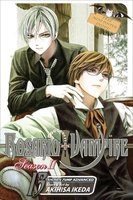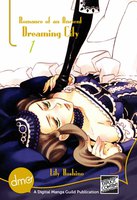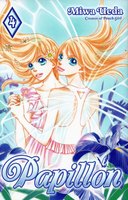RIGHT TURN ONLY!!
Love the One You're With
by Rebecca Silverman,

I've mentioned before (although I think it was in a forum thread, so you may not be aware of it) that I collect old American romance comics from the 1950s – 1970s. (There's a little bleed over into the 40s and 80s.) If you've never read one, it's a totally different experience than reading a manga romance, but boy are they a lot of fun. It's an interesting way to track societal expectations of romance and gender roles, for one thing, and for another it's a great way to watch colloquial language change. Marvel had a really funny conceit where their authors were credited as “As told to Stan Lee” rather than “By Stan Lee,” so I always get this image of some poor teenager pouring her heart out to Uncle Stan so that he could write her troubles down in “His Hair is Long, but I Love Him!” (an actual title from the early 70s). In any event, now you too can experience these gems of pop culture history – IDW has started to release some of the stranger stories from the old magazines in their series “Weird Love.” I'm stupidly excited, because some of the pre-code stories from the 40s and 50s are really hard to find, but also because where else can you read a comic about a matchmaking bear?
Outside of manga, I mean - does Nagoya the rooster from My Little Monster count?

DEMON LOVE SPELL
Vol. 6
(by Mayu Shinjo, Viz, $9.99)
FROM THE BACK COVER:
Final volume!
Shrine maiden Miko has sealed the powers of the sexy incubus Kagura, who has vowed to protect her. Kagura has been losing his powers ever since Miko's father cast a spell to prevent Kagura and Miko from making love. The spell must be broken for Kagura to survive, but will Miko's father relent?
REVIEW:
Demon Love Spell's final volume is something of a rarity – a Mayu Shinjo manga that has a hero who understands that no means no and a heroine who isn't afraid to say it. (Okay, actually now that she's no longer writing for Sho-Comi, that statement isn't entirely fair – her more recent works are considerably tamer than her earlier infamous stuff.) Miko and Kagura have had a tumultuous relationship throughout the previous five books, and Shinjo resolves things very nicely in this sixth, establishing a give and take relationship between the two that feels like it could continue to work. Naturally this involves sex, but when it comes to it, Miko is the one who initiates and tells Kagura that it's okay. Not that there aren't some uncomfortable moments with Miko pretending she doesn't want Kagura's attentions, but on the whole, this is surprisingly empowered for a Shinjo story, and she doesn't skimp on the happily ever after.
There are two storylines within this volume, with the latter being more urgent (Kagura may die!) and the former, about the spirit of a sakura tree and his relationships with humans, being quite sweet. Both work fairly well, and the sakura spirit plot is a little bit stronger. It touches on human selfishness with regards to nature, and while it doesn't quite achieve the same emotional pull as the kitsune story from earlier volumes, it does still have some weight. The sakura spirit is also very different looking from Shinjo's usual male characters, and some of the monsters are likewise interesting, with a couple looking like evil pokemon. There isn't a whole lot of personality or depth to any of the characters, but the conclusion is satisfying nonetheless.
RECOMMENDATION: Borrow it from a library or a friend. Demon Love Spell is fun and much less offensive than other Mayu Shinjo series, but it also isn't all that well-plotted or developed. Think of it as the Harlequin of manga romances – fun, but not great.

KNIGHTS OF SIDONIA
Vol. 10
(by Tsutomu Nihei, Vertical, $12.95)
FROM THE BACK COVER:
As though dissatisfied that the war against the Gauna is entering a lull, humanity struggles with monsters of its own making.
REVIEW:
It's a little disingenuous to say that the war against the Gauna is at a lull in this volume, because as we know from Tsumugi, the gauna/human hybrid, the “monsters” humans are making are gauna. As numerous other science fiction series have learned, messing around with the powers that be rarely leads to Tsumugi-like results, and the scientists of the Sidonia are very quickly learning that themselves. Almost everything is connected to this idea of building a hybrid, which is very impressive – even the seemingly silly first chapter about a tentacle monster haunting the girls' photosynthesis chambers is part of the plot. Only the last chapter, about Izana and Tanikaze on a “mission” orchestrated by Izana's grandmother, doesn't quite fit the master plot, although it does work with the romantic subplot that's been building almost since the series started. We don't see much of the vast reaches of space this time around, or any major battles, but the daily struggles are the characters are still complex enough to keep eyes glued to the page. The “towns” of the Sidonia are so intricate as to be labyrinthine, with something to look at no matter how long you stare at the page. This almost forgives the fact that pretty much everyone looks alike. (Reincarnations, soul transfers, and twins can only give Nihei so much slack.) The most visually unique character is Tsumugi, and her snaky form is better off not being seen close up, as we learn when there's a zoom in on her “face.” Gauna resemble a cross between a Titan and some of Johji Manabe's bug ships, depending on their form, and this becomes very pronounced in this book. The busy art can get tiring on the eyes (and mind, a little), but it's still quite remarkable – both in story and in art.
RECOMMENDATION: Buy it. It may lack the grandeur of earlier ones, but the story keeps on moving in a manner befitting an epic. Knights of Sidonia is still an amazing work of science fiction.

ROSARIO + VAMPIRE SEASON II
Vol. 13
(by Akihisa Ikeda, Viz, $9.99)
FROM THE BACK COVER:
Average human teenager Tsukune accidentally enrolls at a boarding school for monsters--no, not jocks and popular kids, but bona fide werewolves, witches and unnameables out of his wildest nightmares! On the plus side, all the girls have a monster crush on him. On the negative side, all the boys are so jealous they want to kill him! And so do the girls he spurns, because he only has eyes for one of them--the far-from-average vampire Moka. On the plus side, Moka only has glowing red eyes for Tsukune. On the O-negative side, she also has a burning, unquenchable thirst for his blood...
When villains' true identities turn out to be nested like Russian dolls... a. dance the squat dance b. find a new body to inhabit yourself c. count your blessings
REVIEW:
This is a final battle that has nearly everything you could want it to have: power ups, allies popping up out of nowhere, secret weaknesses, double-crosses, despair, hope...you name it, Akihisa Ikeda hits it. The only thing it's really missing at this point is something that traditionally has been a staple of this series – fanservice. Unless you're in an art history frame of mind, there really isn't any in this book, which might be a disappointment to some fans, but in the end does help to keep the action flowing without distraction. (The art history bit? Gyokuro's final transformation would make Georgia O'Keefe proud.) There isn't really a moment to catch your breath as Tsukune and the gang put their lives on the line to stop the resurrection of Alucard, evading death at every turn, only to have the ending of the book rip that sigh of relief right away from you. Ikeda's art is attractive (albeit occasionally static) and gross when he needs it to be - this is an intense volume...and one that's a little nasty to boot. There's some graphic violence with nastily burbling bodily fluids, ripping, and cutting going on, so if your stomach is sensitive, you want to go in prepared. But the excitement of the story makes up for that, and those who have been following the series should find themselves turning pages quickly to see how things are going to turn out...and then looking up when the next volume hits the bookstores.
RECOMMENDATION: Buy it. I've had mixed feelings about this series, but this really is an exciting battle volume, and the four-panel strips at the end are funny too.

MY LITTLE MONSTER
Vol. 3
(by Robico, Kodansha, $10.99)
FROM THE BACK COVER:
Haru confirms his love for Shizuku after a talk with the class rep, Chizuru Oshima (who also has feelings for Haru!). Meanwhile, confused and unsure, Shizuku decides to eliminate her feelings towards Haru so that she can concentrate on school. Will Haru be able to change her mind? The school festival brings chaos and rivalries, and passions ignite!
REVIEW:
Talk about back and forth – first Haru said he liked Shizuku and she said she didn't like him, then they both reversed their positions, and now Haru's realized that he does like her, but Shizuku's decided that love makes her not concentrate on school, so she doesn't like him. As one might imagine, this does not sit well with Haru, who's never been great with impulse control – he names a barricade he builds “Shizuku Mizutani” and makes at least one comment that won't sit well with all readers. The more interesting struggle, though, is Shizuku's. As many people know, you can't necessarily “turn off” your emotions just because you don't think they're in line with your goals, and Shizuku is figuring this out the hard way. (Does she ever do anything the easy way?) When you come right down to it, it looks an awful lot like she's simply afraid of what will happen if she allows herself to change. In her mind, she's always been “studious,” to the point where it has eclipsed all other activities and facets of her personality. If she admits that she still likes Haru (when he's been quite open about the fact that he likes her), that will have to (in her mind) change. And change is scary – we have Oshima right there to show us that it doesn't always work out well with her subplot about attending a different high school than her friends and getting bullied, not to mention Haru's suspicious past. So it really does feel easy to get inside Shizuku's head and understand why she's so reluctant to engage in a romantic relationship with the guy who is, for all intents and purposes, her best friend. Not that it isn't a little frustrating to see the romance stutter along...but it is less of an annoyance than it often is. In fact, the far more irritating issue with this volume is one that readers of Kodansha's releases will be familiar with – the binding is way too tight, causing some of the inside edges of the story to be difficult to read. Um, at least the spines don't break?
RECOMMENDATION: I'm really torn between “buy it” and “borrow it.” I didn't inhale this volume as rapidly as the previous two, but I did enjoy it quite a bit. Understanding Shizuku's reluctance sets this apart as a romance, but there's also a real sense of “one step forward, two steps back.” If you've been on the fence about this series, this volume probably won't bring you into the fold and you should borrow it, but if you've been enjoying it, you'll probably want to buy it.

WANDERING SON
Vol. 7
(by Shimura Takako, Fantagraphics, $24.99)
FROM THE BACK COVER:
Shimura Takako's groundbreaking, critically acclaimed, and beloved series continues to explore gender identity among its cast of middle school students.
Nitori-kun, our boy who wants to be a girl, gets the first signs of acne. This may be the end of the world. But when Nitori-kun turns to nationally famous model Anna-chan for help, events take an unexpected turn. Then, the theater club scouts Nitori-kun and Chiba-san after the success of their gender-bending play. But when Takatsuki-san, the girl who wants to be a boy (and whom Nitori-kun has a wicked crush on), congratulates Chiba-san, Chiba-san (who has a wicked crush on Nitori-kun) calls Takatsuki-san a hypocrite. With all of this drama, what's going to happen when there's a school ski trip?!
REVIEW:
The back copy actually makes this volume sound much more drama-heavy than it is. As is the norm for most manga by Takako Shimura, the primary conflicts happen inside the characters' heads, and while there is some external action, this volume is really no exception. The main issue covered this time – apart from Nitori's horror at getting his first pimples – is the question of sexuality. Previously we've seen the feminine Nitori crushing on the masculine Takatsuki, and the temptation has been to assume that he likes her as a girl likes a boy. (Nitori pondered this as well.) But now Nitori has a crush on a different girl: Anna, Maho's model friend. How does it fit in with Nitori's identity? The question is pondered much more by Nitori's friends than by Nitori, which is certainly worth thinking about: why are we all so preoccupied with who someone likes and how? This question continues throughout the volume as Chiba learns that Nitori's affections have shifted and she reacts badly, taking it out on Takatsuki...at first. The evolution of the characters' relationships is definitely a highlight of the volume, as well as part of what makes Shimura's story so relateable. Even if you don't identify with the characters' gender identity issues or questions of sexuality, we can all remember the day-to-day dramas of being in middle school, and Shimura handles them with a sort of calm realism that helps to make the book stand out, whether it's the grumble of a girl who wishes it wasn't that time of the month or the confusion of a boy when people don't act in line with his previous expectations. And as always Fantagraphics has put out a beautiful product with color pages and clear images. There are no translation notes this time, just a few footnotes, but there are also no “just google it” comments, so I suppose that evens out.
RECOMMENDATION: Buy it. This is a sensitive, beautiful portrayal not just of LBGTQ kids, but of real kids in general. Plus the book is gorgeous and cheaper if you know where to look.

ROMANCE OF AN ANCIENT DREAMING CITY
Vol. 1
(by Lily Hoshino, eManga, $7.95)
FROM EMANGA:
Princess Olga lives inside a gilded cage. Denied the right to choose her future or even whom she may love, she seeks solace and escape in magic and the collection of magical artifacts. Through the enchantment of a golden circlet, she is transported to an exotic land very different and yet so very similar to hers, where she meets Abed, a young woman in similar circumstances. Between them lies a mysterious box with magic to grant them power over their destinies — but how high is the price for Olga's freedom?
REVIEW:
Initially I picked this out to read because I had so enjoyed the anime of Hoshino's Otome Yōkai Zakuro. While Romance of an Ancient Dreaming City's first volume does share a certain mysticism with Zakuro, there really is no other comparison to be made. This story follows Olga, the princess of a vaguely Renaissance kingdom. Olga's father wants her to pick a husband, and so in the tradition of the old tales, she sets impossible tasks for her suitors...hoping that none will succeed. Olga is deeply unhappy with her life: she isn't ready to marry, she doesn't like the queen (presumably her stepmother), and her friend Giotto is now her bodyguard and treats her as an assignment. This unhappiness has caused her to lash out at those around her, which in turn gives her a reputation as a bitch. Then one day during a visit to the royal wizard, Olga slips on a circlet which transports her to an ancient Egyptian-esque kingdom. There she meets Princess Abed, who owns many of the same supposedly magical items Olga has in her world. The two girls become friends, but Abed is clearly not telling Olga everything, as we find out in the last chapter...
It's a shame that this is the only volume translated to date, because this is a captivating, albeit occasionally uncomfortable story. Hoshino's art is beautiful and dreamlike with fantastic costumes and delicate lines, and the tension that simmers beneath the surface makes it hard to stop reading. The whole book has the feel of one of Charles Perrault's original tales – dark, sad, and yet somehow still hopeful. I use Perrault and not Grimm because Romance also is very sexual, and eManga won't let you read it without verifying that you're at least 18. There is one very graphic ritual rape scene in the end and an attempted rape earlier, with neither played off as fanservice, although I suppose that depends on your point of view. Abed's Egyptian-style dress leaves her breasts bare, so there's plenty of that to see as well. If this doesn't put you off, however, Hoshino's story is really fascinating, the Digital Manga Guild's translation very smooth, and the artwork beautiful. Dark fantasy fans shouldn't miss this.
RECOMMENDATION: Read it. Some of the graphic sex is off-putting (especially that rape scene at the end), but the story itself is fascinating and really pulls you in, and the art really is lovely.

PAPILLON – HANA TO CHO
6 of 8 volumes released
(by Miwa Ueda, Del Rey, $10.99)
FROM THE ENCYCLOPEDIA:
Ageha is an ordinary girl who feels inferior to her twin, Kana. Ageha grew up in the country with her grandma and Kana in the city with her parents. Ageha is plain, boring and unpopular while Kana is the exact opposite. Because of the grandma's health they now live together and go to the same school. The two sisters fight for the attention of a boy name Ryuusei, however, their motives are very different. With the help of an eccentric school counselor named Kyuu, Ageha will go through a metamorphosis.
THOUGHTS:
There's something wonderfully frustrating about really melodramatic shoujo. (The only other medium that can match it is a Kdrama.) When it comes to heroines fighting against truly terrible high school villains – who, of course, used to be their allies – it's pretty hard to top Miwa Ueda's series. While Peach Girl was fully released, Ueda's Papillon – Hana to Cho (translation: Butterfly – Flower and Butterfly) was halted with two volumes to go. Like Peach Girl, Papillon followed an ordinary and misunderstood high school girl who is plagued by an outwardly friendly/nice foe. In this case, the former is Ageha and the latter is her identical twin sister Hana. Hana is horribly jealous of Ageha, who was sent away to be raised by her grandmother for health reasons, and is now out to sabotage her sister's life. Ageha, meanwhile, finds solace in the advice of guidance counselor in training Kyu, who helps her to transform herself into a more confident person. Then she falls for him and he unprofessionally decides that they can date, and I started to feel kind of icky about the whole series.
Really the romance was the least enjoyable part of Papillon, but for catty high school meanness and a truly bitchy antagonist (even if we can see why she is the way she is as the story goes on), it was one of the best. Ueda's use of body language and posture is also excellent, and if she tended towards psychobabble and pop psychology in her free talks, well, those are easily skipped. On the one hand, it's a shame that this ended with only two volumes (or one omnibus, as five and six were released) to go, but on the other, that relationship between Kyu and Ageha was really not okay – at least in my mind – so maybe it's just as well that it stopped where it did.
So that's our show for this time! Now I have to go see a man about a boat (translation: help my father bail the boats), so I'll catch you in the forums and in two weeks with another thrilling installment!
discuss this in the forum (20 posts) |